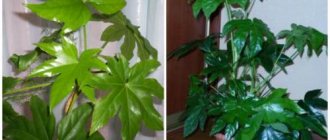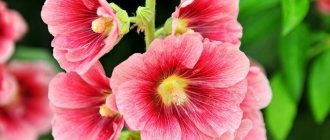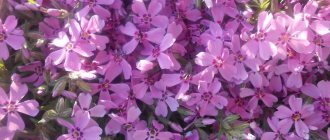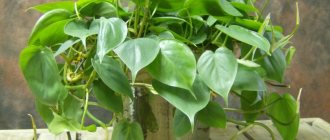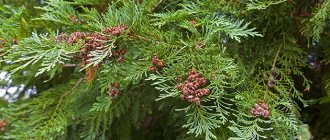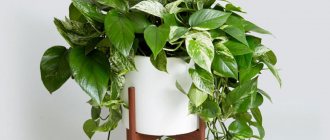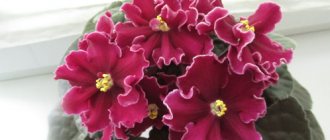Description
Garden ivy (Hedera helix) is a climbing vine-like perennial evergreen plant of the Araliaceae family. The Latin name comes from the Greek word "oedon" - singer. There is another version of the origin of the name from the Celtic word “hedea” - cord. The specific name comes from the word “helisso” - to curl.
This plant is widespread in South-West Asia, Southern, Western and Central Europe. On the territory of our country, garden ivy grows in the Caucasus and the territory of the Krasnodar Territory, in the Crimea. The natural habitat of ivy is beech and oak forests; it can also be found in lowlands and foothills.
Garden ivy is a heat-loving plant, but there are also frost-resistant varieties.
Most types of ivy have leaves that are leathery, shiny, and have a smooth surface penetrated by numerous veins. Depending on the type, the leaf plates can be three-toed, five-toed, or heart-shaped.
The color of the leaves is usually a solid green. However, there are species with variegated leaf blades: with yellow splashes, red stripes and white edging around the edges.
The plant is capable of growing over various surfaces due to numerous sucker-like aerial roots, which can cling not only to trees and their branches, but also to rough stone walls.
The length of ivy shoots can reach three meters in length. During the flowering period, the plant produces small greenish-yellow flowers, collected in umbrellas, which are of no decorative value. Flowers are very attractive to various insects, including bees.
After pollination, small berries of a dark, almost black color are formed on the ivy, which become a real decoration of the plant.
Please note that ivy is a poisonous plant, and the poison is contained in all its parts and, if it comes into contact with the skin, can cause itching, redness and even burns. However, not all people are susceptible to poison ivy. In any case, when working with this plant, it is recommended to use gloves to protect your hands.
Ivy in garden design
Decorative ivy for the street is in great demand in landscape design. Ivy can be used to make hedges, wrap around house walls, stones and pillars; its roots with suckers will rise to any height. It should be noted that before wrapping ivy around the walls of houses, it is better to seal the cracks and cracks - ivy has a habit of crawling into them and spreading into them, this will make the cracks even more noticeable.
In the conditions of the Moscow region, many forms overwinter under the snow; they are used as decorative ground covers in shady corners of the garden. In the south of Kazakhstan and the Caucasus, they prefer to wrap ivy around fences and walls. These are very beautiful hedges. Here we took cuttings (photo clickable):
Here is today's brief information about decorative street ivy, the popularity of which remains significant over the years. If the conditions of your region allow, grow evergreen garden ivy: planting and caring for it is not burdensome, and its decorative value is very high.
Kinds
The plant has 16 species. They differ in the shape of the leaves and their color, flowering time, and temperature conditions of growth. In our country, gardeners grow only a few frost-resistant species.
Common ivy (Hedera helix)
This species is most widespread in our country because it is frost-resistant. Common ivy has a slow growth rate and can be grown not only as a garden plant, but also as a house plant. Loves a windless, shaded place and is easy to care for.
It has flexible vines that grow up to one meter in length, with alternately arranged glossy leaves. Each leaf blade is divided into three lobes and covered with bright veins.
Popular types and varieties
How indoor ivy or hedera propagates
The plant is a heat-loving crop, so it is most often found in the south. Some frost-resistant vines grow in temperate climates. Here are the main types of ivy:
- ordinary. This is the most common plant that is used for planting outdoors and indoors. The leaves are medium-sized and have a five- or three-fingered shape. Depending on the variety, the foliage may have blotches or shine. Growth is moderate, reaching up to 20 m in length, weaving around nearby surfaces. Ivy is used for vertical gardening of structures and buildings. It is better to plant in partial shade. The most popular frost-resistant varieties are Goldhert, Mona Lisa, Eva, Sagittaefolia;
- Caucasian, or Colchian. This is a fast-growing plant species characterized by large dark green leaves and strong shoots. The liana is capable of weaving a surface up to 30 m high and grows in the shade. Popular garden forms - Dentata Variegata, Arborescens;
- Crimean. Ivy is unpretentious, grows quickly, and is resistant to cold and drought. As it grows, there is a lignification of the shoots that wrap around shrubs and trees. The length of an adult vine reaches up to 30 m, and the trunk in circumference is up to 1 m.
Each type has its own characteristics and features, but they are ideal for garden landscaping.
Features of cultivation
Selecting soil and planting location
Garden ivy is an unpretentious plant that grows on almost any soil, except clay, which delays the supply of oxygen to the root system. Moreover, clay can retain moisture, which can lead to rotting of the ivy roots.
The best option for growing would be soil with lime and humus, that is, a moisture-intensive and breathable substrate.
Variegated varieties of garden ivy are planted on the sunny side, choosing a place in such a way as to prevent direct sunlight. For plants with dark green foliage, choose a shady place. There should be a support for the vine near the planting.
Temperature, humidity, watering
The development of the plant in the first two years after planting occurs rather slowly. In this regard, it is recommended to plant ivy in open ground in the spring, so that in the warm season the plant has time to become as strong and established as possible, and its root system has grown.
Garden ivy tolerates changes in ambient temperature normally. However, for cultivation in regions of our country where winters are often cold, it is imperative to choose frost-resistant species.
Being in dry air can cause the leaves to dry out and die. In this regard, regular spraying of the leaves may be required.
Since garden ivy is a moisture-loving plant, you should ensure that the substrate in which it grows is always moist. Moreover, ivy loves to be sprayed, so it is preferably watered using the sprinkling method. In summer, water often enough, at least 1-2 times a week, making sure that the earthen ball does not dry out; in winter, watering the plant should be reduced.
Loosening
Garden ivy needs regular loosening of the soil. If the soil has dried out due to insufficient watering, it is watered abundantly and loosened. Loosening is also carried out to prevent earth crusts from appearing after rain. The loosening process also helps to increase the breathability of the soil layer. However, this should be done carefully so as not to damage the roots.
Fertilizer and feeding
To speed up plant growth in the spring and summer, it is recommended to fertilize garden ivy once every two weeks. For feeding, you should use fertilizers for ornamental plants that contain nitrogen. In order for the plant to better survive the winter, starting from mid-summer, you can feed it with fertilizers containing potassium and phosphorus.
You can also fertilize ivy using manure mixed with water.
Transfer
Garden ivy does not tolerate transplantation well. Gardeners should carefully choose a planting site, remembering that the plant may die as a result of replanting.
Features of care
Further care for ivy will not cause difficulties.
- If the plant is young, it should be directed towards a fence, wall or other support along the twine. Then it will cling to vertical surfaces on its own.
- It is necessary to water moderately, avoiding stagnation of moisture, which can cause rotting of the root system.
- You can feed once a month with mineral or organic fertilizers. During the active growing season, use nitrogen fertilizers; at the end of summer and beginning of autumn, use potassium-phosphate fertilizers.
- The soil should be periodically loosened, and its surface should be mulched around the plant. Leaf humus, peat or wood chips are suitable for these purposes.
The young plant must be covered for the winter. You can carefully remove the ivy from the support, place it on the ground, cover it with dry leaves and cover it with a box. Snow cover will enhance protection against freezing. In spring, the plant is lifted and tied up again. As soon as the ivy rises above 1.5 m, gains strength and mass, it can not be removed.
Periodically, ivy should be trimmed, removing excess and forming a crown. Cuttings can be rooted, thereby propagating the plant.
Reproduction methods
When propagating garden ivy, gardeners do not have any serious problems. This plant propagates easily; a large number of seedlings can be quickly grown from one bush.
Flower growers prefer the vegetative propagation method. This allows you to preserve species characteristics, which is rarely achieved when growing ivy from seeds.
When using vegetative propagation methods, you must follow the following rules:
- annual or biennial shoots are used for propagation;
- it is necessary to choose strong shoots with aerial roots;
- carry out the reproduction process in late spring or early summer;
- It is recommended to plant young plants in a new place in early autumn or spring. The latter is more preferable, as the plant will have more time to adapt and prepare for winter.
Ivy care
Common indoor variegated ivy flower
The wind carries whiteflies, mites, aphids, and thrips that are dangerous to ivy. Insecticides must be used immediately as soon as pests are noticed on leaves and stems.
Note! Diseases and parasites can be recognized by yellowed, pale or fallen leaves.
Sometimes it is necessary to repeat the procedure for getting rid of pests.
Propagation of ivy by cuttings
It is recommended to use apical cuttings that can multiply quickly. To grow a seedling you need:
- Cut cuttings up to 10 cm long that have at least one healthy node.
- Plant in a pot or root in loose soil in a greenhouse, water.
- Replant the ivy to a permanent location when a sufficient number of roots have formed.
For your information! Cuttings from a young plant take root poorly and sometimes even rot.
Preparing for winter
Low temperatures can have a detrimental effect on the plant, especially in the middle zone. Covering the soil with an additional layer of mulch will help protect the vine. In winter, it is recommended to sprinkle snow up to 30 cm high on the soil. Experienced gardeners cover lashes that grow vertically with polyethylene or burlap.
Important! In early spring, the top layer of covering should be removed to avoid damage to the stems due to high humidity and temperature.
Planting an outdoor plant in a pot
By layering
Like other vines, garden ivy can be propagated by layering. This method is used most often when ivy is grown as a ground cover plant: branches lying on the soil are able to take root without outside help, but by stimulating this process, gardeners get new plants faster.
To carry out this method of propagation, the shoot should be laid on the ground and attached to the soil with special staples, and then sprinkled with nutritious soil. Small cuts are made on the bottom of the branches, which helps speed up the rooting process. It is necessary to water the cuttings regularly, maintaining stable soil moisture. After the vine has strengthened, you need to wait until spring or autumn and transplant the already strong ivy to the desired location.
Ivy (willow)
Ivy is a genus of plants that belongs to the Araliaceae family. The genus has 16 species, which are divided into many varieties.
Ivy plants, regardless of species or cultivar, have a creeping stem and are all subshrubs. Their shoots are divided into two types: flowering and non-flowering. On flowering shoots, the leaf blades are light green or light green and have an ovoid or oblong shape. On non-flowering leaves, the leaves are dark and angular-lobed.
The fruit is a small berry that is black or yellowish in color.
The plant is found in regions with a humid climate.
The plant can reproduce by seeds, but this method is not used in gardening, and the seeds are used exclusively for animal feed. This is because the seeds, as is the case with many other crops, do not retain the qualities of the mother plant. For decorative purposes, the plant is propagated in only two ways: layering and cuttings.
Cuttings
Most often, garden ivy is propagated in this way, since it is quite simple and fast. The roots of the cuttings appear in just a few weeks. Cuttings can be taken at any time of the year, but it is better to use young shoots. For propagation, both apical and stem cuttings are used. The length of the apical cuttings should be from 9 to 21 cm, the lower two pairs of leaves should be removed. The cuttings must have an aerial root. If propagation is carried out by stem cuttings, then a young whole shoot with 8-10 leaves is used.
You can grow cuttings in water or a special solution that stimulates the development of the root system. It is allowed to use a mixture of peat and sand.
Any temperature above +15 degrees is suitable for rooting cuttings.
After rooting, the young plant should be grown in a container, and young ivy can be transplanted to a permanent place in the spring with the arrival of warmer weather.
Propagation of evergreen ivy
Most species suitable for growing in the garden form adventitious or aerial roots. This makes it quite easy to root cuttings taken in the spring and summer months.
Semi-lignified shoots with visible rudiments or already real adventitious roots are suitable for ivy propagation. If you cut off very young, green growth, the rooting process takes much longer. And under unfavorable conditions, for example in cool weather, the cuttings may even rot.
To propagate evergreen ivy, it is better to use apical cuttings, but if this is not possible or you need to get a lot of young plants, the shoot is cut into 10 cm fragments, with at least one healthy node.
You can root the cuttings in an outdoor greenhouse, planting several of them in loose, light soil, or in plain water. When a sufficient number of roots appear on the stems, the plants are transferred to their future location. Taking into account the growth of ground cover shrubs and the peculiarities of caring for garden ivy, planting is carried out at a distance of at least half a meter from each other.
Seeds
This is the most difficult method of propagating garden ivy. The seeds are removed from the berries after ripening and dried for one to two days. Plant the seeds in prepared containers with a nutrient substrate, in which drainage holes are made, then water generously from a sprayer. After this, the containers are covered with glass, which is best not to be opened in order to maintain the greenhouse effect. Watering is carried out from a tray on which the containers stand. The first shoots should appear in 15-25 days.
Possible problems
Despite the fact that ivy is a fairly unpretentious plant, some problems may arise when growing it.
If the leaves on evergreen garden ivy begin to turn yellow, the plant does not have enough water, and if the leaves begin to fall off, it means that the ambient air is very dry. Problems are solved by watering and spraying foliage.
If the plant does not have enough light, the variegated and bright green leaves will become faded. This problem can only be solved by transplanting the ivy to a more illuminated place.
How to plant a green ivy fence
A hedge of evergreen ivy can be an excellent backdrop for garden flowers, alpine slides, and even a playground. Therefore, the choice of landing site must be taken very seriously. But first you need to purchase seedlings.
Garden ivy is propagated by cuttings, layering, and shoots (ready seedlings). If there is nowhere to take cuttings, much less make layering, then you need to choose seedlings in the nursery very carefully. Healthy leaves and roots are a sure sign of a strong plant. If you have doubts about the appearance of a young seedling, then it is better to refuse to purchase it. A weak, unhealthy plant is unlikely to take root.
Ivy is an unassuming plant. It tolerates both heat and snowy cold winters well. However, when choosing a place to plant it, it is better to avoid the sun. There are also no special requirements for soil composition. But, if we take into account that this plant was brought to us from humid places with fertile soils, then the applied fertilizers will contribute to the lushness of the vine, as well as the exceptional shine of the foliage.
The best time to plant a hedge is from late April to late May. Before planting, make the necessary markings and install supports. Small holes are dug along the supports, the distance between which must be maintained within half a meter. The diameter and depth should be such that the roots fit freely. The soil inside each hole needs to be thoroughly loosened and fertilized with compost or humus. After planting, abundant watering is required.
Diseases and pests
Evergreen garden ivy is resistant to disease, however, when grown in too wet soil, the ivy may become infected with a fungus (rust, root rot). In this case, it is enough to remove damaged shoots with leaves covered with dark spots, treat the plant with a fungicide and reduce the intensity of watering.
Garden ivy is attacked by parasites such as spider mites, scale insects and aphids. If parasites are detected, it is necessary to immediately remove the damaged shoots and spray the ivy and plants planted in close proximity to it with the Actellik insecticide. If it was not possible to get rid of the insects the first time, the chemical treatment should be repeated after a week.
Hedera flower. Description, features, types and care of hedera
It is medicinal, but the berries are poisonous. Heder's indoor ivy . A tincture of its leaves is used as an anti-inflammatory and antifungal agent. The plants avoid berries.
The poison of the fruit causes vomiting, nervous system disorders, and dizziness. However, most consider Heder's ivy as an ornamental deciduous vine.
Hedera is often used in vertical gardening.
She decorates houses and gardens, climbing fences, columns, gazebos, and room partitions. Without support the Hedera flower becomes ampelous, that is, it hangs freely from wall pots.
Description and features of Hedera
Hedera is a plant of the Araliaceae family. There are more than 70 genera in it. All from the tropics and subtropics. Hedera , in particular, is imported from Africa, Europe and southern Asia. There, in natural conditions, the vine stretches 80 meters.
When grown in rooms, Hedera branches grow up to 6-15 meters. This makes it possible to form the likeness of trees from thin and flexible shoots, running along a vertical base. Sometimes, ivy wraps around wire figures in the form of hearts, geometric shapes, and animals.
The appearance of ivy exactly describes its name. The Celtic word hedea translates to "cord". The shoots of the plant really resemble long ropes and threads. At least the braids of the whip.
Moving upward, Hedera is attached to a vertical support with additional roots. Disc-like extensions form at their ends. They resemble suction cups and act similarly.
Ivy leaves are what Hedera is planted . The main decorative element of a vine. The shape of the green plates is considered one of the prototypes of the heart. The hypothesis correlates with the beliefs of the ancient Greeks. They viewed ivy as a symbol of unbridled fun and love.
Hedera leaves are located on petioles. They alternately move away from the trunk. The leaves on the petioles are leathery, dense, shiny. In natural ivies they are usually dark green.
In the photo Hedera with berries
Therefore, the plant is considered shade-tolerant. However, among the selection varieties there are variegated ones with an abundance of white spots. These people need bright light. Otherwise, the greenery loses its characteristic color, and with it its decorative effect.
It is interesting that on vines that are not capable of bearing fruit, the leaves are 3 or 5 lobed. On flowering branches, the green plates are ovoid or heart-shaped, without pointed edges.
Hedera domestica produces inconspicuous, small, white-green buds. They are collected in inflorescences-umbrellas, and those, in turn, in brushes. Berries form at their ends. At first they are green. When ripe, the fruits turn black or blue. Round seeds are visible through the shell of the berries. There are 3-5 of them in one fruit.
Hedera appears in photographs with berries only in its natural environment. In Russian gardens, ivy does not have time to form fruits, since they appear almost 9 months after flowering.
The latter starts at the end of August – beginning of September. The berries ripen by May. It is clear that such a development schedule is acceptable only for the tropics. In Russia, the fruits of Hedera can only be seen indoors. But ivy rarely blooms in them. The minimum age for fruiting is 10-12 years.
Ivy shoots are harvested as medicinal raw materials during the flowering period. Greens are usually dried, chopped and brewed. Only tinctures are made from fresh shoots. In Germany and France, ivy is a component of a number of official medicines. In Russia, Hedera is used only in folklore.
In the photo Hedera variegated
The biologically active substances in ivy greens are triterpene saponins. Many of them are derivatives of oleanolic acid. In Heder, 50 species of saponins were counted.
The substances can lower blood cholesterol. Therefore, ivy is suitable as an anti-atherosclerosis agent. Also, saponins can weaken and serve as diuretics.
Reproduction and planting of Hedera
Propagation of Hedera requires cuttings. These are sections of branches with 2-4 internodes. Usually, 8 centimeters of stem is enough. Cuttings separated from ivy in the summer take root better.
To avoid cutting off the vine, take the tops of its shoots. They remain from pinching, which stimulates branching of the bush. The length of the shoots decreases slightly.
Hedera cuttings give roots in plain water. You just need to defend it. You can add a drop of growth stimulator. With the appearance of roots, the shoot is moved to a pot with soil made of turf, humus and sand. The components are mixed in equal proportions. You can also add peat.
Hedera at home is planted with several cuttings in one pot. This forms a lush bush. Otherwise, the vine looks like a lonely lash, the same cord that is hinted at in the name of the plant.
The photo shows Hedera seeds
Sometimes, ivy cuttings are obtained immediately with roots. To do this, take a 10-centimeter section of the vine and place it horizontally in the substrate, sprinkling it so that the leaves remain on the surface.
Hedera's aerial sucker roots quickly transform into underground ones. All that remains is to dig up the branch, divide it into cuttings with one leaf and plant them in pots.
In the absence of a plant from which to take cuttings, gardeners buy ivy or its seeds. The price of the latter is 50-150 rubles per package with 1 gram of grains.
Their germination rate is average, but a bag is enough for one lush bush. In the store they ask for 300-300 rubles for such a copy. The average price of small ivy without crown formation is 500-900 rubles.
Caring for Hedera
Hedera can be picky at home. In particular, the vine does not like to be moved. Due to frequent rearrangements, Hedera sheds its leaves and flowers. They also do not like drafts, direct rays of the sun, or excessive dry air. In winter, ivy has to be illuminated, extending the day by 3-5 hours.
Due to the shallow root system, caring for Hedera comes down to selecting shallow but wide pots. They are needed so that the plant feels at ease, and the water is distributed correctly when watering.
The first pot for ivy is of medium size. When replanting, the volume of the pot is doubled. Small containers inhibit the vine, forcing it to take root deeper, which is not typical for it.
Hedera is replanted once a year in youth and once every 3 years in adulthood. The last age is considered to be from 3 years. It is possible to replace only the top layer of soil. Approximately 5 centimeters are removed. This temporary measure will delay the transplant by about a year.
The composition of the soil for ivy shows that the plant loves fertile soil. Therefore, in indoor conditions you cannot do without fertilizing. They take complex ones, with both organic and mineral components. Fertilizers are applied to the soil a couple of times a month. In winter, it can be reduced to once every 30 days.
The watering regime for Hedera in winter and summer also differs. On warm days, the earthen ball should be constantly moist. Consequently, summer watering is plentiful. A 3-centimeter layer of expanded clay at the bottom of the pot and a drainage hole in it allow you to avoid rotting of the roots.
In winter, when the room is cool, you can completely refuse watering. When the air is heated, the flower continues to be given water, but not more than once every 7-10 days. Water with a soft liquid that has been left for several days.
The picture shows views of Hedera
The water should be warm. Hedera generally loves warmth. 25 degrees in an apartment is normal for ivy. The critical minimum is 14 degrees. Beyond this threshold is a decrease in the flower’s immunity and susceptibility to disease.
Hedera needs increased air humidity. The plant, as we see, is a lover of excess. The air in homes is often dry. You need to buy humidifiers or systematically spray the vine. By the way, she also loves bathing in the shower.
Types of Hedera
There are 15 species in the genus Hedera. There are 4 common varieties in potted floriculture. The first of them is Hedera “Helix” . Otherwise, the species is called “Ordinary.” It comes from Europe and “reaches” the Caucasus mountains.
The leaves of "Hilix" are 3- or 5-lobed, dark in color, but with whitish veins. All varieties of the species love soil rich in minerals. The vines especially like salt in the ground.
With them, plants bear fruit abundantly. By the way, Helix berries are large, up to a centimeter in diameter. Being poisonous to humans, the fruits feed blackbirds, willows and other birds.
Header mix photo
The second type of ivy, beloved by flower growers, is “Kenarskiy.” Otherwise it is called Hedera “Mix” . Varieties of the species come from Africa and Portugal and are distinguished by large white-yellow leaves.
In contrast to their beauty is the lack of aerial roots in “Mix”. Without them, the plant cannot deftly climb the support. Ivy species have to be given a reliable base and helped to wrap around it.
The third type of cultivated ivy is “Colchis”. He comes from Asia. It is also found in Iran and beyond the Caucasus. There, Hedera shoots climb to heights of 30-40 meters. As we understand, “Colchis” varieties do not have problems with air suckers.
The leaves of “Colchis” ivy are whole, shaped like hearts and have a nutmeg aroma. It is the smell of the nut that encourages many gardeners to start plants at home.
The size of the leaves is also attractive. They reach a length of 25 centimeters. The main thing is to prevent the vine from blooming. Its buds, in contrast to the greenery, smell bad.
Pictured is Hedera Helix
It remains to mention Khedera “Pastukhov”. Russia is a natural environment for this ivy. Varieties of the species are also found in Azerbaijan and the Caucasus. In the domestic expanses of Hedera, “Pastukhova”, however, flourishes only in Dagestan. From there the shoots are brought to the country's flower shops.
Ivy "Pastukhov" is included in the "Red Book" of Russia. Varieties of the species are distinguished by the presence of aerial roots, but the lack of the ability to attach to rocks.
Another difference between Pastukhov is the dark green color of the leaves on top and light green on the back. It is also interesting that the green plates at the base of the shoots are round and have a solid edge. At the tops of the branches there are both dissected and rhombic leaves.
Diseases and pests of Hedera
Pests love Hedera. The liana suffers from mites, scale insects and thrips. We calculate the first ones by the cobwebs on the leaves. The presence of the latter is clear from whitish spots and sticky grease on the greenery. Thrips discolor the leaves and leave punctures on their edges. These are traces of the penetration of the proboscis of an insect drinking the juices of a plant.
The surest way to get rid of insects is insecticides. Chemicals are sold in gardening and flower shops. There are means of complex action. Only the Hedera crown is processed.
The photo shows a Hedera leaf drying due to lack of moisture.
Ivy is accompanied by diseases caused by growing conditions. So, with a cramped pot, the foliage becomes smaller. It begins to dry out at the ends in insufficiently humid air, especially at elevated temperatures.
Overwatering leads to yellowing of the foliage. It loses color in low light. The second consequence of lack of sun is stretching of the stems. The leaves move away from each other. Liana ends up half naked.
It becomes clear why Hedera is not included in the list for beginning gardeners. The beauty of ivy is worth the sacrifice and knowledge. If the article adds to the latter, the reading was not in vain.
